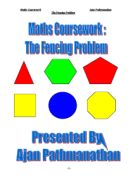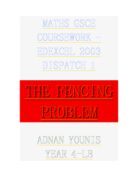From the above table I will now plot a graph of base length against area to show the relationship between both. (Graph is on next page)
As you can see from my graph it has formed a parabola. According to the table and my graph, the rectangle with a base of 250 meters has the largest area. This shape is also called a square or a regular quadrilateral.
Because I only measured to the nearest 10 meter, I cannot tell whether the graph is true. I will now work out the results using 249m,
All these points are reliable to my graph. Now I have found that a square has the largest area in the rectangles group.
Triangles
I am now going to find the triangle with the largest area. I will only be using isosceles triangles. This is because if I know the base length, then I can work out the other two lengths. If the base is 200m long then I will do the following calculation
Side = (1000 - 200) ÷ 2 = 400
To work out the height I will use Pythagoras thermo
H2 = h2 - a2
H2 = 4002 - 1002
H2 = 150000
H = 387.298
H = 387.298
Area of a triangle
= ½ X base X vertical height
= ½ X 200 X 387.298
= 38729.833m2
Below is a table of result for isosceles triangles from a base with 10m to a base with 500m.
Side = Where X is the base length. I have used this formula to work out the area when the base is different heights. To do this I need to use Pythagoras' theorem. Below is a diagram of the isosceles triangle.
Because the regular rectangle was the largest before, I added 333.3 as a base length. This is the length of the base of a regular triangle.
I will plot a graph so it is base against area (See next page)
As you can see this graph is a-symmetrical. The regular triangle seems to have the largest area out of all the areas but to make sure I am going to find out the area for values just around 333.
This has proved that once again, the regular shape has the largest area.
Because the last 2 shapes have had the largest areas when they are regular, I am going to use regular shapes from now on
Pentagons
The next shape I will be investigating is the pentagon
A pentagon has five sides. It can be divided into 5 segments. Each segment will for a isosceles triangle.
To work out the top angle I did the following calculation
360 / 5 = 72
The other Angles can be worked out by dong the following calculation
180- 72 = 108
108 / 2 = 54
All isosceles triangles can be split into 2 right angled triangles.
Firstly I will take an isosceles triangle from the pentagon. The triangle has a side of 200m long and a base of 100m.
Using trigonometry I will calculate the height of the triangle
Therefore the area of the triangle is
Area = ½ X base X Vertical Height
=½ X 100 X137.638
=6881.9m2
This is only the area of one segment so I will multiply this number by 10 to get the full area.
Total Area = 6881.9 X 10
=68819 m2
From now on I can work out the area of any shape
Hexagon
I will now investigate the hexagon
The hexagon has 6 sides. It can be divided into 6 segments. Each segment will be a right angled triangle.
To work out the top angle I did the following calculation
360 / 6 = 60
The other angles can be worked by doing
180- 60 = 120
120 / 2 = 60
To work out the area I did
1000 / 6 = 166 .1666666
166.1666666 / 2 = 83.333333
360 / 6 = 60
60 / 2 = 30
Area = ½ X base X Vertical Height
=½ X 83.333333 X144.338
= 6014.065m2
Total Area = 6014.065 X 12
=72168.784 m2
Heptagon
I will now aim and find the area of a seven sided shape. This is a Heptagon
I will now a series of calculations
1000 / 7 = 142.857
142.857 / 2 = 71.429
360 / 7 = 51.429
51.429 / 2 = 25.714
Area = ½ X base X Vertical Height
=½ X 71.429 X144.323
= 5297.260m2
Total Area = 5297.260 X 14
=74161.644 m2
From this we can see that my prediction is true as the number of sides increases the area also increases.
Below is a table showing the number of sides against area
As you can see, the larger the number of sides on the shape the larger the area is. The pattern has carried on going for all the shapes that I have looked at, so I am going to investigate shapes with a huge number of sides.
Below is table showing my results
I will now plot a graph so it is the number of sides against area. (Graph on next page)
Circles
Circles have infinite amount of sides so I cannot use the equation I used before for the other shapes which I have looked at.
To work out the area I will use π
Here is the formula that I used to work out the diameter
Circumference
π
So I did 1000 ÷ π = 318.310
- ÷ 2 = 159.155
Area = π X159.1552
= 79577.472m2
This gives the maximum area that is needed
Conclusion
Overall I have found out that the circle with a circumference of 1000m gives the largest area and this is what the farmer has to use so he gains the largest area.







